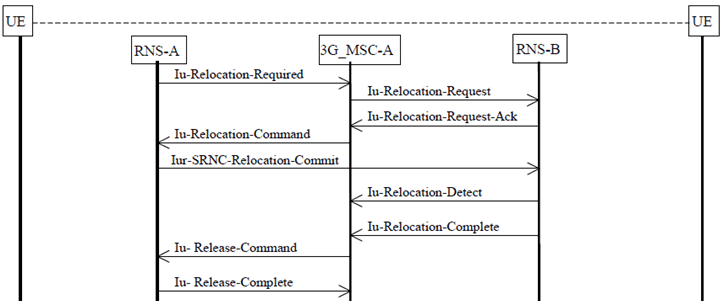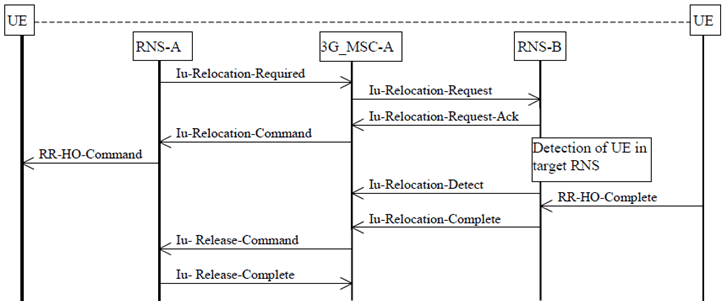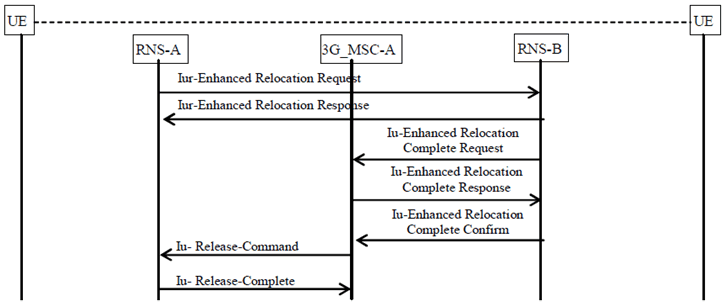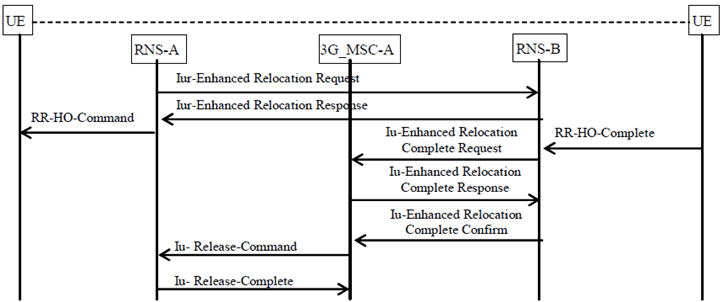Content for TS 23.009 Word version: 18.0.0
1…
4…
4.3…
6…
6.2…
6.2.3
6.3…
7…
7.2…
8…
8.1.3…
8.2…
8.2.2…
8.2.4
8.3…
8.3.2…
9…
10…
11…
12…
12.8…
12.8.2
12.8.3
13…
14…
15…
6.2.3 Procedure for Intra-3G_MSC SRNS Relocation p. 35
The procedure for a successful Intra-3G_MSC SRNS Relocation is shown in Figure 10 and Figure 11. For a successful Intra-3G_MSC Enhanced SRNS Relocation the procedure is shown in Figure 11a and Figure 11b. SRNS Relocation and Enhanced SRNS Relocation are used to relocate the serving RNS functionality from one RNS to another. The procedures may or may not involve change of the radio resources assigned for the corresponding UE. Whether or not the Relocation includes change of radio resources assigned for the UE does not affect the SRNS Relocation procedure or Enhanced SRNS Relocation procedure in the Core Network.
In case of subsequent Intra-3G_MSC-B SRNS relocation or Intra-3G_MSC-B Enhanced SRNS relocation the following applies:
- If 3G_MSC-B has previously received an order to perform location reporting at change of Service Area from 3G_MSC-A and if 3G_MSC-B also supports Location Reporting Control, it shall issue the Iu-LOCATION-REPORTING-CONTROL message towards the target RNS immediately after successful completion of relocation. Upon receipt of Iu-LOCATION-REPORT, 3G_MSC-B shall forward it towards 3G_MSC-A via E interface. If 3G_MSC-B supports location reporting at change of Service Area and if encapsulated BSSAP signalling is used on the E-interface, 3G_MSC-B shall always initiate the Location Reporting Control procedure at change of Service Area towards the target RNS, since no request for Location Reporting can be received from MSC-A. In that case, if an SRNS relocation is used, the Location Reporting Control procedure shall be initiated by 3G_MSC-B after the Relocation Resource Allocation procedure has been executed successfully; otherwise 3G_MSC-B shall initiate the Location Reporting Control procedure when the completion of the Enhanced SRNS Relocation has been confirmed by the target RNS. The change of Service Area shall be reported to MSC-A within an A-HANDOVER-PERFORMED message.


Figure 11: Basic intra-3G_MSC SRNS Relocation Procedure combined with hard change
(⇒ copy of original 3GPP image)
(⇒ copy of original 3GPP image)
of radio resources (Hard Handover with switch in the Core Network)


Figure 11b: Basic intra-3G_MSC Enhanced SRNS Relocation Procedure combined with hard change
(⇒ copy of original 3GPP image)
(⇒ copy of original 3GPP image)
of radio resources (Hard Handover with switch in the Core Network)
6.2.3.1 With no bearer or one bearer p. 37
6.2.3.1.1 SRNS Relocation |R8| p. 37
The successful operation of the SRNS Relocation procedure is as follows. When the Serving RNS (RNS-A) makes the decision to perform the SRNS Relocation procedure it will send an IU-RELOCATION-REQUIRED message to the 3G_MSC (3G_MSC-A). The IU-RELOCATION-REQUIRED message shall contain the identifier of the target RNS to which the Relocation is to be performed. When the 3G_MSC-A receives the IU-RELOCATION-REQUIRED message it shall begin the process of relocating the serving RNS functionality to the new RNS (RNS-B). The 3G_MSC-A shall generate an IU-RELOCATION-REQUEST message to the selected RNS (RNS-B). For the relocation of a speech call to UTRAN Iu mode, 3G_MSC-A shall include the NAS Synch Indicator in the Iu-RELOCATION-REQUEST, if the Iu Selected codec to be used after the relocation is different from the Iu Currently used codec.
If 3G_MSC-A supports SRNS Relocation to a CSG cell and RNS-A includes a CSG ID for the target cell in the IU-RELOCATION-REQUIRED message, then 3G_MSC-A shall check the CSG membership of the UE for the target cell as described in subclause 4.3.1 before generating the Iu-RELOCATION-REQUEST message. If the UE fails the CSG membership check and the target cell is a CSG cell, 3G_MSC-A shall send an IU-RELOCATION-PREPARATION-FAILURE to RNS-A.
When RNS-B receives the IU-RELOCATION-REQUEST message it shall take the necessary action to establish the new Iu transport bearers for each Radio Access Bearer related to 3G_MSC-A for the UE in question, this is detailed in the 3GPP TS 25.430 series and TS 25.413.
Once resource allocation has been completed by RNS-B it shall return an IU-RELOCATION-REQUEST-ACKNOWLEDGE to 3G_MSC-A. When this message is received by 3G_MSC-A, and 3G_MSC-A is ready for the move in Serving RNS functionality, it shall indicate the completion of the preparation phase on the core network side for the SRNS Relocation. An IU-RELOCATION-COMMAND message is sent by 3G_MSC-A to RNS-A. RNS-A acts as follows:
- if the procedure is a SRNS Relocation without change of radio resources, which means that the Iur interface between RNS-A and RNS-B can be used for the procedure, the RNS-A shall send IUR-SRNS-RELOCATION-COMMIT message to the RNS-B to trigger the Relocation execution. See Figure 10.
- if the procedure is a SRNS Relocation with change of radio resources, which means that the Iur interface between RNS-A and RNS-B is not used for the procedure, the RNS-A shall trigger the handover procedure on the air interface by sending the RRC-HANDOVER-COMMAND to the UE. The UE will then access the new radio resources. See Figure 11.
6.2.3.1.2 Enhanced SRNS Relocation |R8| p. 38
The successful operation of the Enhanced SRNS Relocation procedure is as follows. When the Serving RNS (RNS-A) makes the decision to perform the Enhanced SRNS Relocation procedure it will send an IUR-ENHANCED- RELOCATION-REQUEST message to the new RNS (RNS B). The IUR-ENHANCED RELOCATION-REQUEST message shall contain the necessary information to set up a CS Radio Access Bearer in RNS-B.
When RNS-B receives the IUR-ENHANCED-RELOCATION-REQUEST message it shall take the necessary actions to establish the new Iu transport bearers for the Radio Access Bearer related to 3G_MSC-A for the UE in question, as described in detail in the 3GPP TS 25.430 series and TS 25.413, and the new transport bearers for the Radio Access Bearer related to RNS-A. to enable data forwarding. RNS-B shall initialize the Iu UP towards RNS A, if necessary.
Once resource allocation has been completed by RNS-B it shall return an IUR-ENHANCED-RELOCATION-RESPONSE message to RNC-A. If the resources cannot be allocated, RNS-B returns an IUR-ENHANCED-RELOCATION-FAILURE message to RNS-A, and RNS-A terminates the procedure.
After transmission of the IUR-ENHANCED-RELOCATION-RESPONSE message RNS-B and RNS-A act as follows:
- If the procedure is an Enhanced SRNS Relocation without change of radio resources, RNS-B shall send an IU-ENHANCED RELOCATION-COMPLETE-REQUEST message to 3G_MSC-A and start data fowarding towards RNS-A for UL data. After receipt of the IUR-ENHANCED-RELOCATION-RESPONSE message RNS-A shall start data forwarding towards RNS-B for DL data. See Figure 11a.
- If the procedure is an Enhanced SRNS Relocation with change of radio resources, when RNS-A receives the IUR-ENHANCED-RELOCATION-RESPONSE message, it shall trigger the handover procedure on the air interface by sending the RRC-HANDOVER-COMMAND to the UE and start data forwarding towards RNS-B for DL data. The UE will then access the new radio resources. When the UE is successfully in communication with the RNS-B, then RNS-B shall start data forwarding towards RNS-A for UL data and send an IU-ENHANCED RELOCATION-COMPLETE-REQUEST message to 3G_MSC-A. See Figure 11b.
6.2.3.2 With multiple bearers (Optional functionality) p. 39
If 3G_MSC-A supports the optional supplementary service Multicall (See TS 23.135), 3G_MSC-A shall have the following functionality additionally to the description in subclause 6.2.3.1.
For SRNS Relocation, upon receipt of the IU-RELOCATION-REQUIRED from RNS-A, 3G_MSC-A generates an IU-RELOCATION-REQUEST message, which may include multiple bearers, to RNS-B.
When an IU-RELOCATION-REQUEST-ACK is received from RNS-B, 3G_MSC-A sends IU-RELOCATION-COMMAND, which indicates the bearers failed to set up in RNS-B as bearers to be released, to RNS-A.
After 3G_MSC-A receives a IU-RELOCATION-COMPLETE message from RNS-B, 3G_MSC-A shall release the calls via RNS-B, which have been carried by the bearers failed to set up in RNS-B, and then sends IU-RELEASE-COMMAND to RNS-A.
For Enhanced SRNS Relocation, RNC-A generates an IUR-ENHANCED-RELOCATION-REQUEST message, which may include multiple bearers, to RNS-B. If resources for at least one bearer are reserved in RNS-B, RNS-B shall return an IUR-ENHANCED-RELOCATION-RESPONSE message, which indicates the bearers failed to set up in RNS-B as bearers to be released, to RNC-A.
When the UE is successfully in communication with the RNS-B, then RNS-B shall send an IU-ENHANCED- RELOCATION-COMPLETE-REQUEST message, which indicates the bearers failed to set up in RNS-B as bearers to be released, to 3G_MSC-A.
After 3G_MSC-A receives the IU-ENHANCED-RELOCATION-COMPLETE-REQUEST message from RNS-B, 3G_MSC-A shall release the calls via RNS-B, which have been carried by the bearers failed to set up in RNS-B, and then sends IU-RELEASE-COMMAND to RNS-A.